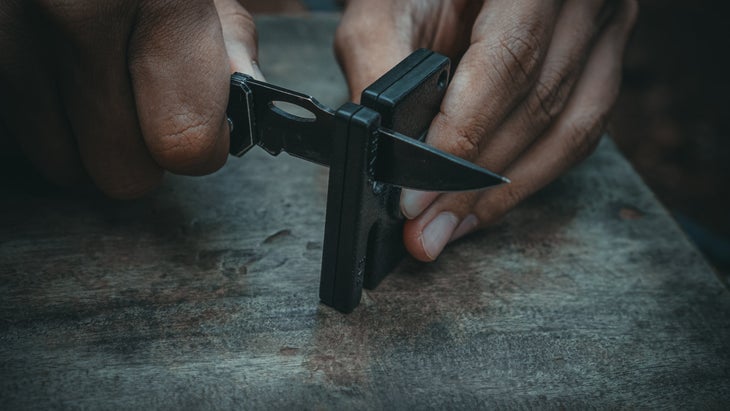Heading out the door? Read this article on the new Outside+ app available now on iOS devices for members! Download the app.
Some people devote their whole lives to learning everything there is to know about making and sharpening knives. These craftspeople are called bladesmiths and can rattle off facts about steel, heat, hardness, and geometry from memory like they’re reading them from a textbook. Without dedicating years to the art, you can still learn how to keep your own knife in working order for slicing, dicing, chopping, and whittling while in the backcountry. Here’s how, according to two knife makers who have collective decades of experience.
Does Your Knife Need Sharpening?
Your knife might look sharp, but does it squish tomatoes’ skin before slicing through them? Are you using muscle to slice summer sausage and cheese for your backcountry charcuterie board? If so, you probably need to sharpen it. The most common indicator that your knife is dull is if it doesn’t cleanly slice paper, says Greg Krieger, a knife maker in Meeker, Colorado.
Other ways to verify it needs TLC: It doesn’t shave arm hair. A noticeable reflective line appears along the edge when you hold it up to a bright light. The blade feels rounded when you gently run your fingers over the edge. It bounces or slides when you tap it against your fingernail.
It sounds counterintuitive, but beyond cutting more quickly and cleanly with more control, a sharper knife is actually a safer knife. Dull knives require more force, increasing the chances of slippage and potential injuries, says Marko Mandić, founder and CEO of Maine-based knife company Tekto.
“Treat every knife like it’s already razor-sharp even when it’s not,” Mandić adds. “We sharpen ‘dull’ knives all the time, but not dull doesn’t mean the same to everyone. This mindset helps prevent accidents.”

Different Ways to Sharpen Knives
Fixed angle and freehand are two common methods of sharpening knives. For beginners and for at-home knife maintenance, Krieger recommends fixed angle sharpening, a system that maintains a consistent, uniform angle between the blade and a sharpening tool.
Freehand sharpening, on the other hand, is often done with whetstones or belt grinders, and requires years of skill and muscle memory to hold the angle steady.
Choose your tool: Whether you’re using a set of Japanese whetstones or a fixed system like the Work Sharp Guided Field Sharpener, it’s going to take practice to learn and get right.
Set the angle: A typical backpacking knife has an angle of 17 to 20 degrees, Krieger says. Meanwhile, kitchen knives are typically set between 13 and 17 degrees, and hard-use knives for prying or chopping wood are between 20 and 25 degrees. “The lower the angle, the better the knife is going to cut,” he says.
Mark your edge: For amateurs and experts alike, both Krieger and Mandić suggest marking the edge of your blade with a Sharpie before sharpening. This will show you exactly where you need to hit the bevel and where you’re gradually abrading material.
Apply pressure: Now you’re ready to make contact. “Regardless of the method, the goal is always the same: to remove material and re-establish the bevel,” Mandić says.
As you make even and controlled passes on one side of the blade with your tool, look for a raised burr—a thin, folded-over piece of metal that looks like foil—along the edge. This is your signal that the edge has been properly formed and is ready for refinement and finishing.
Once you’ve created a burr on one side, flip it over and repeat on the other side.
Refine the edge: Knife manufacturers use various honing, stropping, and polishing methods to remove remaining burrs and finish a knife, but Krieger says that at-home sharpeners can simply use a piece of cardboard with some buffing compound or automotive polish to further smooth it.
Another DIY technique: “You could hang a piece of denim or leather from a hook, put some tension on it and use it as a strop,” he says.

Why Isn’t Your Knife Getting Sharp?
Maybe you followed all the steps above, but your knife still won’t slice paper like butter. People can encounter two main problems when sharpening a knife, Krieger says.
The first is that they’re not fully forming an apex, meaning the edge is not coming to the perfect zero it needs to be sharp. This requires more passes with your sharpening tool to form a burr.
The second is that maybe you’ve fully formed the apex and burr, but now you’re having trouble removing the burr. This can occur with lower-quality steels used on cheaper knives, he adds.
“If you just learn these basic diagnostic tools, your edges are going to immediately improve,” says Kreiger, who has been working with knives for 15 years. “You’ll just get better and better at it.”
From 2025